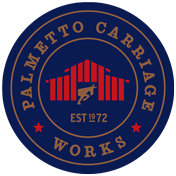Founded in 1670, Charleston (or “Charleston Towne,” as it was named for King Charles II of England) is one of the most historic cities in the United States. In fact, within just ten years of its founding, it became the fifth biggest city in the country.
Today, millions of people (yes, millions!) flock to Charleston each year to take in its Lowcountry charm and learn about its tumultuous history. Palmetto Carriage Works takes roughly 200,000 tourists and locals alike for rides of our beautiful city each year. Understandably, we have different routes that are approved by the city, so not everyone will see the same things. However, each path has a historic majesty all its own. From the open air markets to the Instagram-famous pineapple fountain, here are 5 historic sites in Charleston you’ll see on a Palmetto Carriage tour:
1) Charleston City Market
The City Market was donated by the Pinckney family with the stipulation that it was used as a market in 1788. The first structure was built between 1788 and 1807. The first market was a beef market, which drew buzzards to the structure. Though these may have been considered a nuisance, they played the important role of cleaning up scraps thrown into the street at the end of the day, and because of this valuable service, they were protected by law.
Many tourists confuse the City Market with the Slave Market. It is undisputed that the City Market was never purposed for selling slaves during the Slave Trade.
2) Rainbow Row
On your way down to the Battery, you might pass by Rainbow Row. This line of row homes is famous for one great reason: it’s beautiful. The row of brightly-colored homes were originally painted to emulate the colonial colors of the Caribbean and were erected between 1748 and 1845.
3) White Point Garden (The Battery)
From White Point Garden, with the beautiful historic homes to your back, you’re able to see Fort Sumter in the distance. Confederate forces fired on the Union garrison at Fort Sumter in the early hours of April 12, 1861, marking the beginning of the Civil War. But this garden has an even darker history than most know. You’ll have to take a tour with us to find out!
4) St. Philip’s Episcopal Church
The Charleston landscape is peppered with beautiful steeples, but none so rich in history as St. Philip’s. This church is registered as a National Historic Landmark and sits at 142 Church St. downtown. Established in 1681, St. Philip’s is the oldest European-American religious congregation in South Carolina and its tower once served as a range lighthouse designed to guide mariners into the Charleston Harbor.
5) Waterfront Park (home of the Pineapple Fountain)
Though this park is not itself historic, as it was constructed in 1990, it has become a fan favorite of tourists and the famed Charleston Pineapple Fountain is just the beginning. Off of Concord St., you can find a splash fountain where kids and adults beat the heat of Charleston summers by jumping in! Along the park, you’ll look out toward Patriots Point and the USS Yorktown. You might spot some container ships, a cruise ship or even a few celebrity yachts that have been known to dock at the Charleston Harbor from time to time. And if you want to park yourself on the bench, the park also now has free Wi-Fi.
What do you hope to see in Charleston on your Palmetto Carriage tour? Tell us below in the comments!
